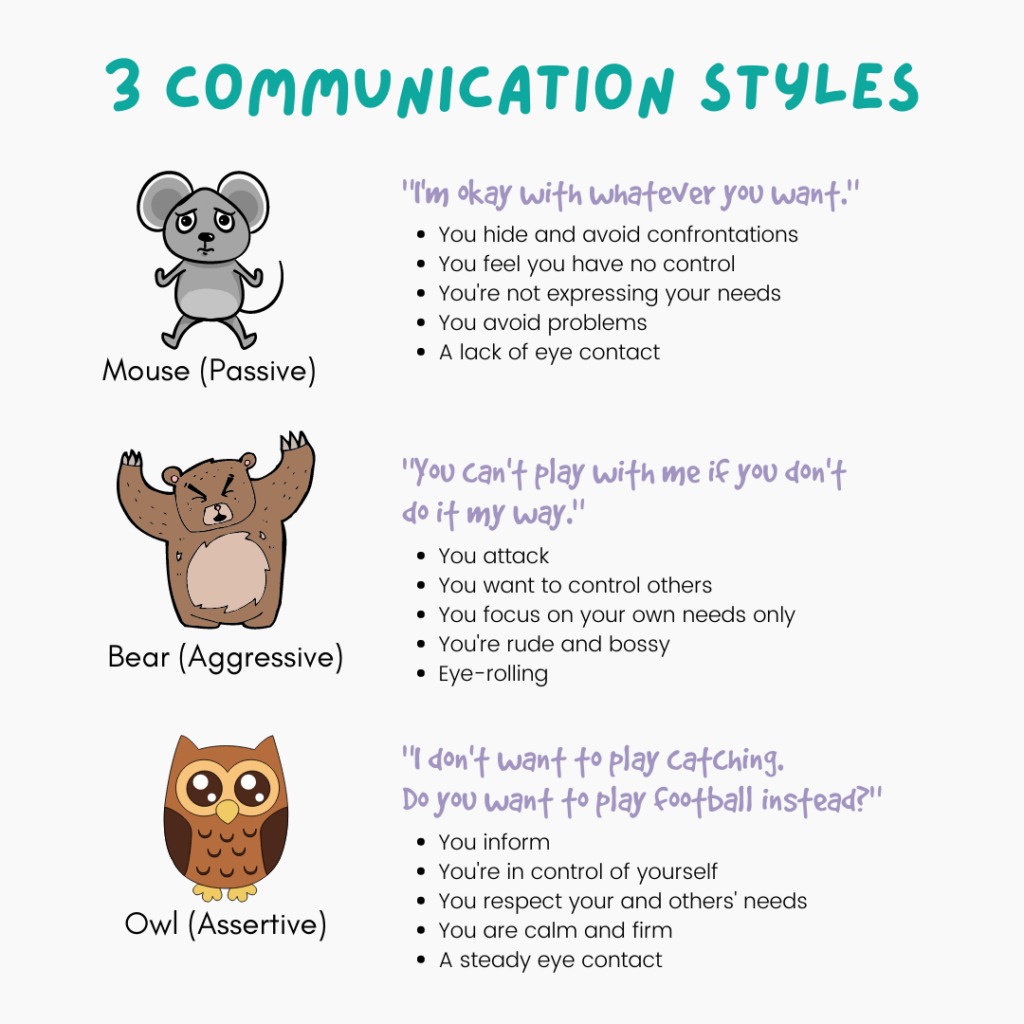To raise strong, confident kids, it is essential to teach assertiveness. An assertive child knows how to stand up for themselves (and others) without being hurtful or mean to anyone. Their ability to say “no,” communicate clearly, and maintain positive relationships meets their own needs as well as those of others.
Assertiveness is not a natural born trait in all of us, and many of us are afraid of appearing rude or selfish if we advocate for ourselves. Assertive communication can be mastered with practice, and kids can gain many benefits as a result.
1. Talk about it
Explain to kids that there are three basic styles of communication. As we interact with other people, we use one of three methods: passive, aggressive, or assertive.
We can figure out our communication style by looking for clues in our words and actions:

Try using animals to represent each style. This is especially helpful for younger children who may struggle with abstract concepts. Encourage them to brainstorm different creatures that they feel most embody the 3 types: passive (a turtle in his shell or a mouse that runs and hides), aggressive (a tiger that attacks or a bear that roars), and assertive (a wise owl or calm family dog who barks at danger).
Praise kids for using their assertive or “owl” communication when handling a tricky situation (“I like how you spoke up!”).
Identify passive, aggressive, and assertive behaviours in their favourite movies and TV shows. Observe how the characters around them react to each type.
Visualise communication in terms of a spectrum, from passive to aggressive–assertiveness is the “sweet spot” in between. Let kids know that they can learn to be assertive regardless of which style they use more frequently!
2. Define boundaries
Talk about the boundaries in the world or lines that shouldn’t be crossed. Stop signs and “personal bubbles” (the space around our bodies) are physical boundaries, while things that hurt our feelings are emotional boundaries.
One way to respect these boundaries is by discussing the power of “no.” Whether it’s an unwanted hug from a relative or a bossy friend on the playground, kids need to hear that assertively saying no is not only acceptable–it’s their right.
Explain the importance of setting healthy boundaries (saying “no,” “stop,” or “I don’t like that”) for the safety and health of our bodies and minds.
Use your discretion to support kids when they say “no” over negotiable issues (not wanting to wear certain clothing, hug someone or read a particular book are good places to start).
Assertive communication means considering the needs of others, but never at our own expense.
3. Teach “I” messages
The “I” message is easy to use and is a very simple formula: “I feel (insert feeling) when you (insert behaviour). I would like you to (insert request).”
For example, “I feel angry when you tell me I can’t play. I would like you to let me join in.
Or, “I feel hurt when you leave me out. I’d like you to stop saying I can’t play.”
The reason “I” messages work is that they are nonjudgmental. No blame or criticism is ever placed on the listener, so it limits the likelihood of the listener feeling attacked or defensive.
Practising similar assertive phrases: ”I need more space”, ”I don’t like it when…”, or ”I think…”
Use a mirror to practice, checking for eye contact and confident posture.
“I” messages can also be used to express the positive impact of behaviour that you would like to see more of. For example, “I loved how you used that ‘I’ message to tell me what you wanted. It made me feel like I wanted to help you.”
4. Build social skills
Having assertiveness skills is not just for dealing with mean kids. Our closest friendships often require us to express our needs and feelings in a healthy and respectful manner.
Start by talking with your child about the qualities they want in a friend. How do friends act? What behaviours make a good friend? Are we being the kind of friend that we want?
Talk about how friendship conflicts are normal sometimes and can actually be an opportunity to develop your assertiveness skills. Together, make a list of some common disagreement sources. For instance:
- Wanting to do different activities at recess
- The feeling of being left out when your friend plays with or talks with someone else
- An overly boastful friend
- Not being invited to a birthday party or an outing.
Role-play one or two solutions for each of these scenarios (using an ‘I’ message is a good start). There may not be a “perfect friendship,” but every relationship can benefit from openness and honesty resulting from assertiveness.
5. Model self-assurance
Kids are more likely to watch what we do than what we say. Our own communication must be assertive if we hope to raise confident children. This isn’t always easy!
Here are some suggestions to get you started:
- Being firm when necessary, and showing your child that you can say (and keep saying) “no”
- Talking about your struggles with assertiveness, and how you overcome them
- Using a calm, assertive tone when stating your views
- Remember to praise yourself (and even reward yourself) for your accomplishments
Assertiveness can also be demonstrated through active listening. In a conflict, try to rephrase what the other person has said before retorting. This is particularly helpful when the disagreement is with your child: “You’re saying ‘no’ to the green top today. I hear you” or “You really want to watch the countdown. It seems like the other kids all get to stay up late.”
Everyone needs practice in assertiveness. When we model assertive communication to our children, both of us reap the benefits, such as confidence and healthy relationships with others.



